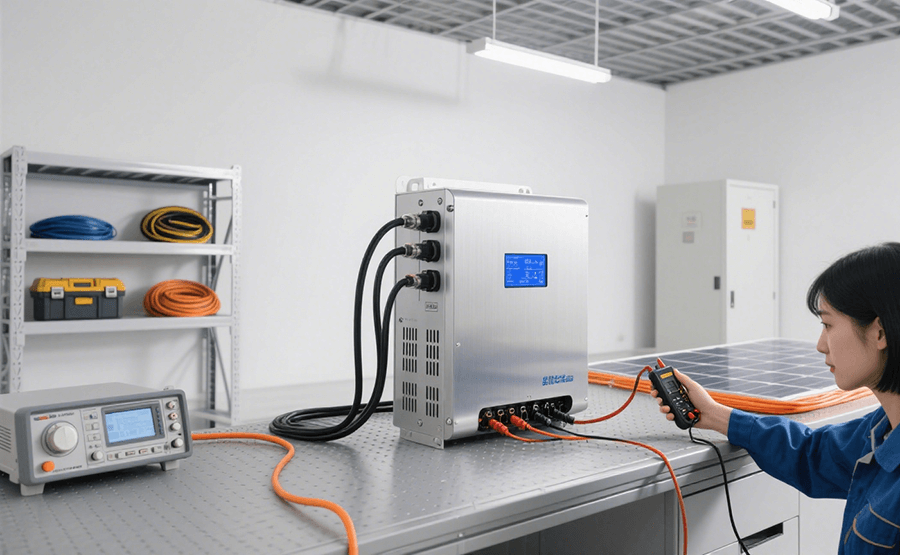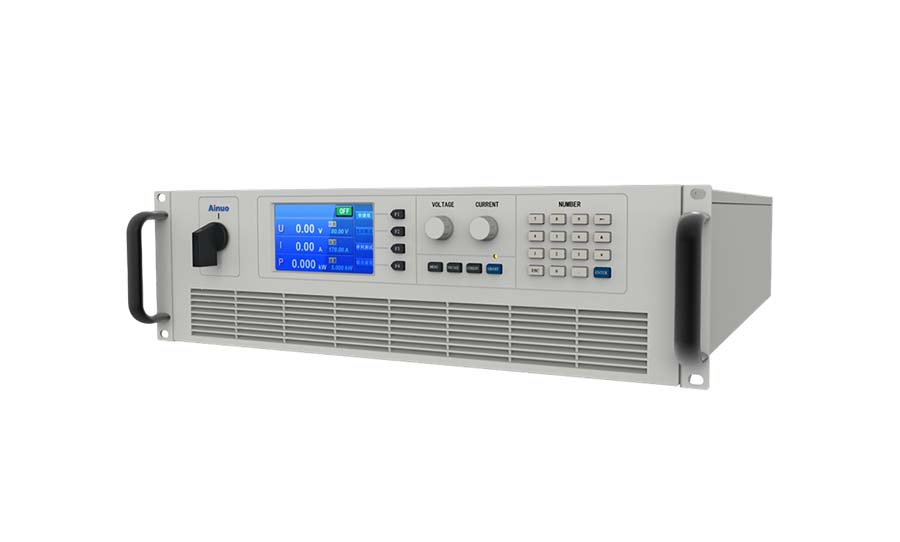Selecting the right DC power supply for PV inverter testing is a critical task for R&D, quality assurance, and production validation. Using a standard lab power supply is often insufficient due to the unique characteristics of solar panels.

Here is a comprehensive guide on how to select the right DC power supply for this application.
The Core Concept: You Need a Solar Array Simulator (SAS)
A PV inverter is designed to extract maximum power from a solar array, which has a non-linear, variable current-voltage (I-V) curve. A basic DC power supply cannot replicate this behavior. Therefore, for accurate testing, you need a Programmable DC Power Supply with Solar Simulation Mode, also known as a Solar Array Simulator (SAS).
Key Difference
Standard DC Power Supply: Provides constant voltage (CV) or constant current (CC). Its output impedance is very low.
Solar Array Simulator (SAS): Can be programmed to emulate the complex I-V curve of a solar panel or an entire array, including its high impedance characteristics. It can simulate changing conditions like irradiance and temperature.

Key Selection Criteria
1. Power & Voltage/Current Ratings (The Basics)
This is the first and most crucial step. You must select a supply that can meet the inverter's requirements.
Voltage Range: The SAS's maximum voltage must exceed the inverter's Maximum Power Point (MPP) voltage range and, critically, its maximum open-circuit voltage (Voc). Always include a safety margin (e.g., +20%).
Current Range: The SAS's maximum current must exceed the inverter's maximum input current (at minimum MPP voltage) and its short-circuit current (Isc).
Power (Wattage): This is simply Voltage x Current. Ensure the total power rating of the SAS is sufficient for the inverter's maximum input power.
2. Solar Simulation Capability (The Critical Feature)
This is what differentiates an SAS from a standard supply.
I-V Curve Programming: The ability to program a full I-V curve by defining key parameters:
Open-Circuit Voltage (Voc)
Short-Circuit Current (Isc)
Voltage and Current at Maximum Power Point (Vmp, Imp)
Dynamic Simulation: The best SAS units can dynamically change the I-V curve in real-time to simulate:
Rapidly Changing Irradiance (e.g., clouds passing by) by modulating Isc.
Changing Temperature by modulating Voc.
MPPT Algorithm Testing: The primary function of the SAS is to test the inverter's Maximum Power Point Tracking algorithm. The SAS must be able to hold a stable, repeatable I-V curve with a distinct "knee" so the inverter's MPPT efficiency and speed can be accurately measured.
3. Measurement Accuracy and Speed
The SAS is not just a source; it's a precision measurement instrument.
Voltage & Current Measurement Accuracy: High accuracy (e.g., 0.1% or better) is required to calculate the inverter's efficiency accurately. Remember: Inverter Efficiency = (AC Power Out / DC Power In) * 100%.
Data Logging Speed: The supply should be able to log voltage, current, and power at a very high speed (thousands of samples per second) to capture transient events and MPPT "hunting" behavior.
4. Transient Response & MPPT Test Mode
Inverters constantly perturb their operating point to find the MPP. This creates a dynamic load that a standard power supply cannot handle.
Low Output Capacitance: Real solar panels have high inherent impedance. A standard power supply with high output capacitance will struggle with the inverter's rapid load changes, leading to instability and oscillations. A proper SAS is designed with low output capacitance to mimic a panel's behavior.
Built-in MPPT Test Functions: Some advanced SAS models have automated test sequences that sweep environmental parameters (e.g., irradiance from 1000 W/m² to 200 W/m² and back) and automatically calculate the MPPT tracking efficiency and response time.
5. Sinking Capability (Regeneration)
When testing inverters, a critical test is anti-islanding (grid-loss protection). During this test, the inverter must shut down. When it does, it stops drawing power, but the DC-link capacitors inside the inverter are still charged.
A non-regenerative SAS cannot absorb this energy. The voltage on its output will rise uncontrollably ("voltage overshoot"), potentially damaging the inverter's capacitors or triggering protective shutdowns on the SAS itself.
A regenerative SAS can act as both a source and an electronic load. It can sink current and absorb this excess energy, safely pulling the voltage down to zero and simulating a real panel's behavior. For full compliance testing (e.g., UL 1741, IEEE 1547), a regenerative SAS is highly recommended and often essential.
6. Control and Software
Front-Panel Control: Essential for basic setup and quick checks.
PC Software: A comprehensive software suite is mandatory for automating test sequences, data logging, generating reports, and plotting I-V curves. Check for drivers (e.g., IVI, LabVIEW, .DLL) that are compatible with your test automation environment.
Selection Process: A Step-by-Step Summary
Define Your Requirements:
List the specifications of the inverters you will test (Max DC Voltage, MPP Voltage Range, Max DC Current, Max DC Power).
Identify the standards you need to comply with (e.g., UL 1741, IEC 62116, VDE 4105, CEC/CGC).
Choose the Type of Supply:
R&D/Validation/Compliance Testing: A regenerative Solar Array Simulator (SAS) is the only correct choice. It is non-negotiable for accurate, reliable, and safe testing of MPPT efficiency, performance, and safety functions.
Basic Production Line Functional Test (Go/No-Go): A high-power, programmable DC source might be sufficient if you only need to verify that the inverter turns on and produces AC power at a fixed voltage. However, it will not test any meaningful performance characteristics.
Specify the Key Parameters:
Power Rating: Add a 20-25% margin to the inverter's max input power.
Voltage Rating: Add a 20% margin to the inverter's max Voc.
Current Rating: Add a margin to the inverter's max Isc.
Must-Have Features: Solar simulation mode, high-speed data logging, high accuracy.
Critical Feature for Safety Tests: Regenerative (sinking) capability.
Evaluate Software and Integration:
Ensure the provided software meets your automation and reporting needs.
Verify communication interfaces (Ethernet, GPIB, USB) are compatible with your test rack.
Example for a Residential String Inverter
Inverter Specs:
Recommended SAS:
Power: 12 kW - 15 kW (with margin)
Voltage: 1200 V (1000V * 1.2)
Current: 20 A - 25 A (to handle Isc and provide margin)
Type: Regenerative Solar Array Simulator
Brand Examples (for reference): Keysight (N8950APV series), Chroma (82xxx series), AMETEK (ELGAR series), Regatron (TopCon series).
By carefully following these guidelines, you will select a DC power solution that not only powers your PV inverter but truly tests it, ensuring it is efficient, reliable, and safe for deployment.




